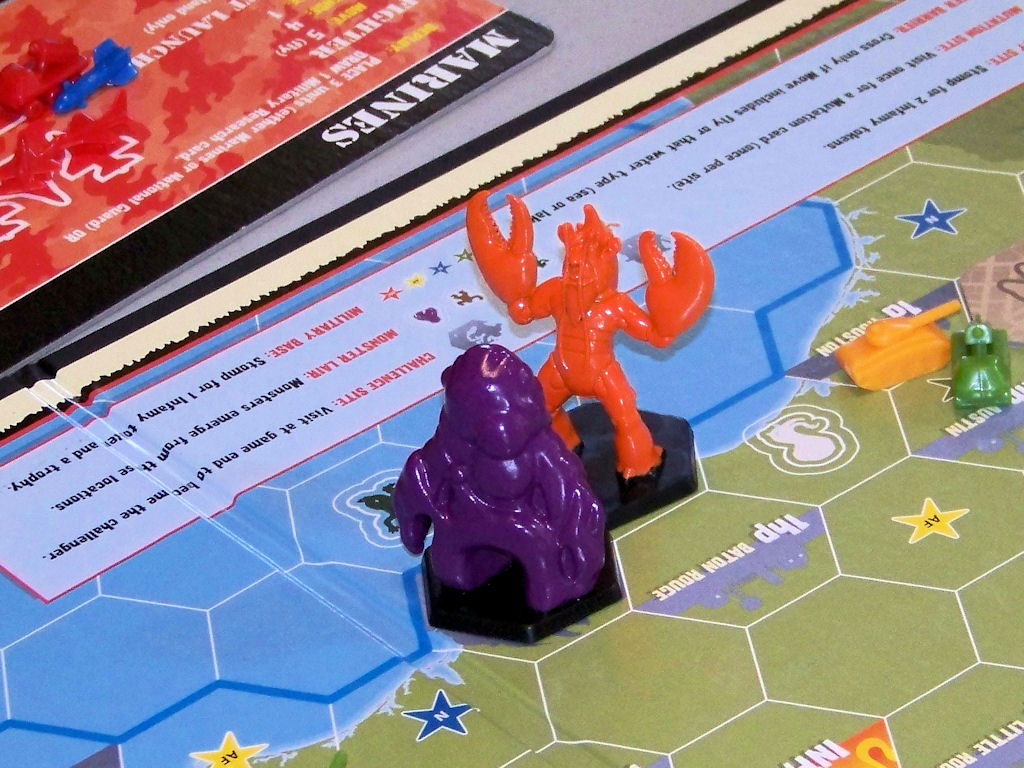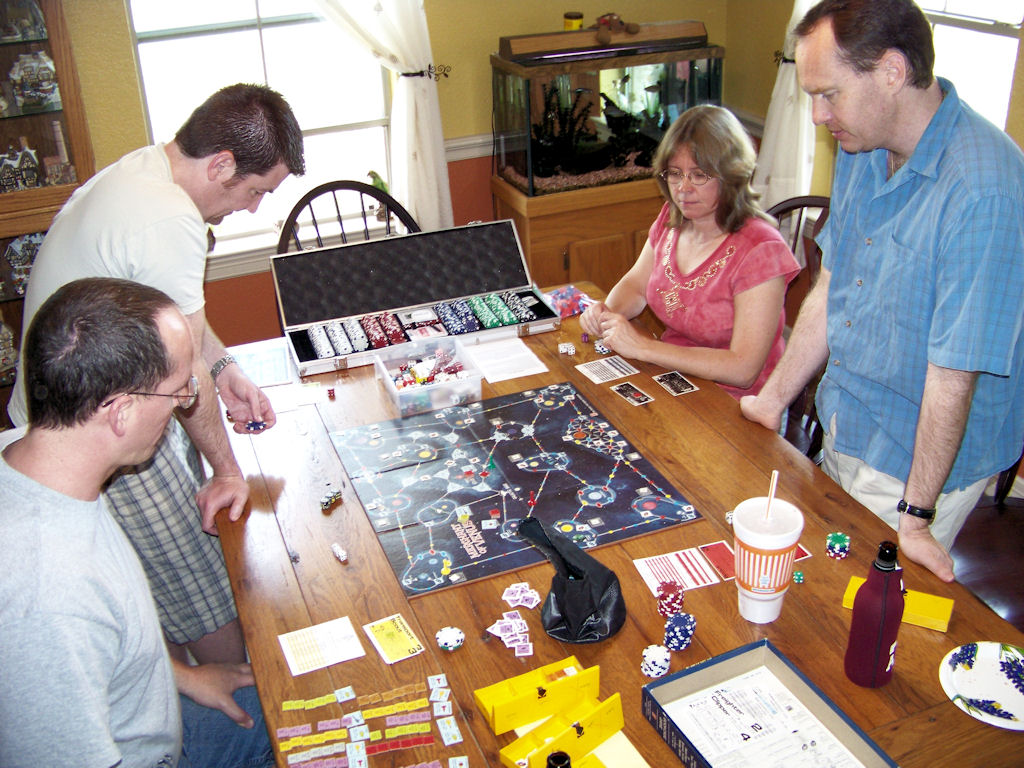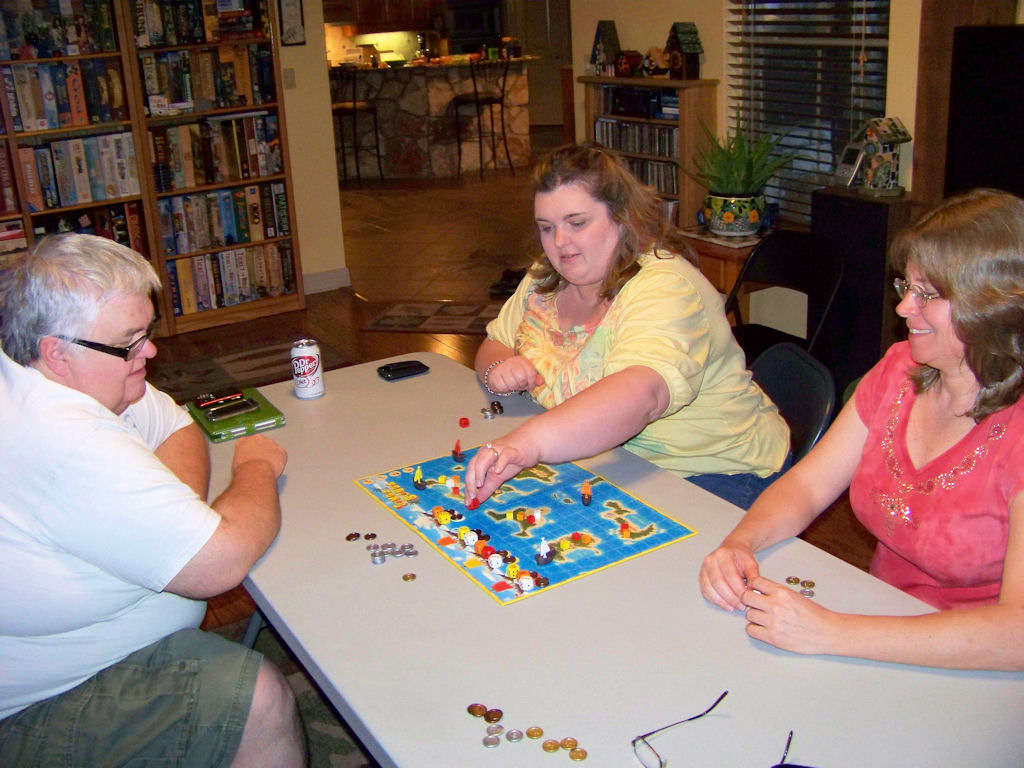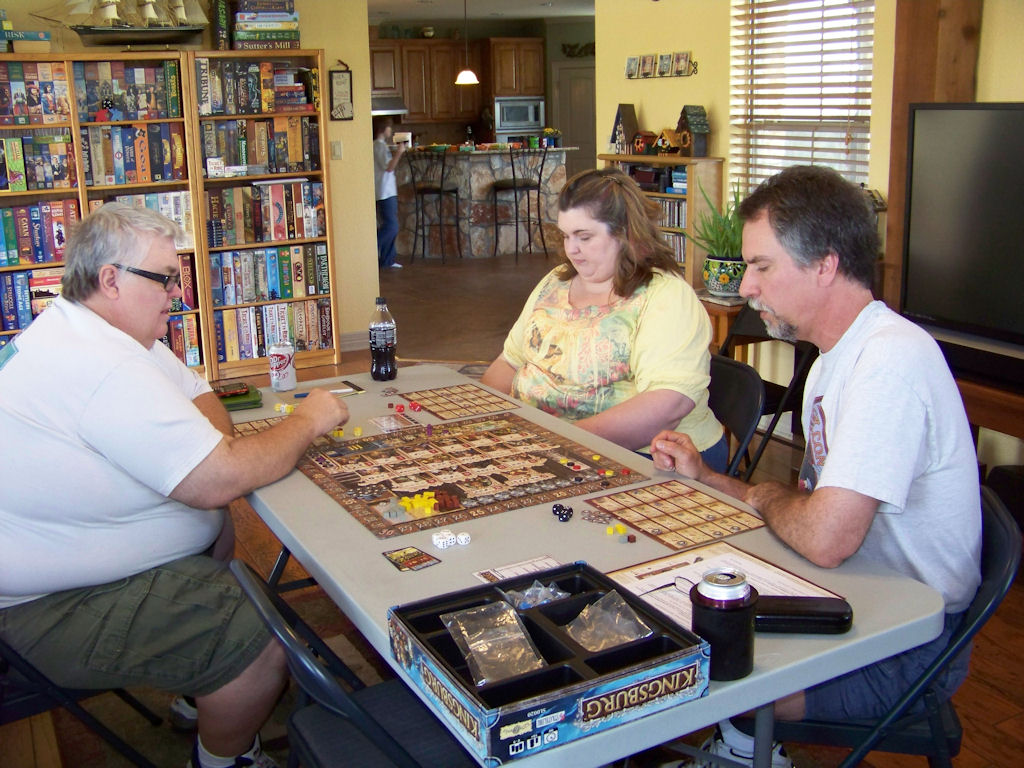
April 21, 2009Game Day Report part 1: Monsters Menace Americaby Susan RozmiarekEvery time we go to Gulf Games, one of my kids latches on to some game that they play there and as good gamer parents, we are obligated to obtain a copy for them once we get home. My kids know that this is one purchasing area where no arm-twisting or whining is required! Anyway, for my younger son Shea, that game one summer was Monsters Menace America. Happily, we were able to get a copy in a math trade on BGG, trading a copy of A Dog's Life that had been plucked off the Gulf Games prize table in the 3rd round solely for its cute rubber dogs. I tried this "dog" of a game (sorry, couldn't help myself) once and thought it quite flawed for reasons I don't remember. There were tweaks, I think, posted online but I couldn't be bothered and onto the trade pile it went. The trade replaced the cute rubber dogs with cute rubber monsters so it seemed pretty even. Unfortunately, as always, once home the kids got back into their routine of computer and video games and couldn't be bothered by the quaint, old-fashioned type of the board variety. So, it's been sitting on the game shelves unplayed for about two years doing nothing more than providing a splash of lime green to my living room decor. I swear that eyeball on the side of the box is watching me every time I walk by. I was glad to finally give it try when new guy Jeff suggested it. I didn't have high expectations but I hate owning games that I haven't even played. I popped the top off the required beer (but alas, we had no pretzels) and sat down for some "mayhem and mass destruction" as stated on the box. The game is really simple. Each player controls a monster and a branch of the military. You move your monster figure across a map of the U.S., stomping cities to increase your health and stomping major landmarks like the World's Largest Ball of Twine for infamy points. Infamy points can be spent to re-roll dice which comes in handy as you will be rolling LOTS of dice in this game. You can also go to places like Three Mile Island where your monster mutates and gains a new power. You randomly draw these from a deck of cards that includes such awesome mutations as Laser Beam Eyes or Atomic Breath. Your monster has a set numbers of spaces it can move each turn and there may be terrain restrictions. Military units are used to simply harass the other players' monsters, bring down their health and discourage them from trying to stomp particularly juicy cities. You get to move your military units on the board each turn and you also have the choice of deploying more or doing military research which entails randomly drawing a card that can be played at the appropriate time to either help yourself or more likely, mess with somebody else. The research card deck includes all sorts of fun things. In our game, Jeff stacked a space with military units and then played the Blond Lure on Joey's monster. Unable to resist this sexy blond siren, his monster was forced to move onto the spot only to discover that it was a trap set by the marines who were waiting to attack. I was able to add Fusion Cells to my units, allowing them to move an extra space each turn. A few of the cards allow you to place and control a smaller monster on the board. There are all kinds of things in the deck. Battles between monsters and military units are simple, with each unit or monster rolling a die and trying to equal or beat the defender's defense number for a hit, in which case it takes a specified amount of damage. Monsters get three attacks per round and if there are any military units left after two rounds, it has to retreat. There is no player elimination. If a monster's health ever gets to zero, he goes to Hollywood as an attraction. Once he gets a certain amount of health back (by rolling a die each turn) he breaks free to continue his rampage across the country. Too funny! The point of all this is to try to beef up your monster for the big monster showdown at the end of the game. Once a certain number of stompings (not a real word according to my spellchecker) have taken place, the showdown will be triggered. This is a fight to the death with the player who triggered the showdown choosing who he wants to fight first. The winner of that battle adds the initial health of his opponent to his monster and chooses the next monster to fight. And so on and so on until one monster is left standing as the King of the Giant Monsters (it's in the rules, I swear) and wins the game. My monster, a pile of purple sludge named Toxicor, won our game, no doubt because he had mutated earlier into a robot that electrocuted his opponents in battle each time they missed. Zap! I can easily see why this game got played over and over again by a pack of pre-teen and teenage boys at Gulf Games. It's perfect for that group. It has practically no strategy but playing it was a hoot, with lots of trash talking. It's simple and short, so it makes a good "beer and pretzels" style game and it captures the humorous, campy feel of the theme very well. This is the type of game that sends many of my gamer friends running away screaming so it definitely needs the right crowd. It's not the sort of thing I'm itching to play all the time, but I certainly had fun. A few extra beers or margaritas might enhance the experience as well. Just saying...
Next up: Conan wanders around aimlessly and a cosmic parasite terrorizes the galaxy.
Posted by susanroz at 5:08 PM
| Comments (1)
Gamer's Notebookby Susan RozmiarekI always feel flattered but very self-conscious when my blog gets linked somewhere else or somebody I don't even know mentions that they read it. It's even worse when somebody as respected in the hobby as Mike Siggins calls attention to it in his column. Yikes! I often forget that somebody besides my local group and me might be reading it. I guess that I shouldn't be too surprised as I "lurk" on many blogs, too pressed for time or just too lazy to comment on the entries. I'm also reminded once again that I've been horribly neglecting my blog lately. We were able to scrape together some friends for games this past Saturday, so I at least have a few things to write about now. Although be forewarned - I'm still recovering from Eurogamer burnout as you'll see from my game choices. Mike's column, Gamer's Notebook, is excellent reading as usual and it includes his Sumo awards for last year's games. I haven't even played his top two games or many of the other games he discusses, showing just how behind I'm getting on the newer stuff.
Posted by susanroz at 5:01 PM
| Comments (2)
April 1, 2009Oldies that definitely aren't moldyby Susan RozmiarekToday was a day of golden oldies in which I discovered an old gem that definitely reinforces the idea that one should not judge a game by its box. And I mean a box with really, REALLY hideous art, the kind drawn by a nerdy teenager. The fact that the game is an old Avalon Hill game with handfuls of little chits (confetti - whee!) and those typically awful black and white rules with a tiny font and numbered sections should not be a deterrent either. Well, not in this case, anyway. The game that I'm talking about is Merchant of Venus and after only one play, I'm totally smitten. My cult-of-the-new-Eurogame-only group has been strangely enamored with this game lately and I'd successfully avoided it until today. It came out in the late '80s, a time when I only lurked on the fringes of gaming and there had to be a dragon or wizard on the box for me to notice a game. The ones I did try, like Dragonhunt and Wizard's Quest, were disappointments at the time that kept me on the fringe. I assumed that Merchant of Venus was some sort of science fiction wargame and I wasn't going to go near something like that. I guess "Merchant" should have been a clue. So, when I was told it was a pick-up-and-deliver game, my protective shields started to crack a little. I ADORE that sort of game. That is exactly what Merchant of Venus turned out to be, with the added fun of an exploration game. Empire Builder (EB) is a good game to compare with Merchant of Venus (MoV) as both games scratch the same itch for me and share many similarities but are also quite different. EB is played on a fixed map and you will always know where each type of good will be found. The random factor is in drawing the Demand Cards that will tell what good needs to be shipped to what location. In MoV, it is the opposite. Each culture produces certain goods, but you will not know at the start where the various cultures are located. The cultures that demand a certain type of good will always be the same but, once again, you will not know where they are located until they have been by exploring the planet locations on the board. Similar to the Empire Builder games, you can upgrade your ship to either be fast or you can choose to sacrifice speed in favor of more cargo space. In EB, the number of spaces you can move on a turn is fixed, depending on the type of engine. In MoV, movement is determined by dice roll, with your ship's speed determining the number of dice you roll. The goal of both games is to be the first to earn a certain amount of money by picking up and delivering goods. You do spend your earnings in MoV to build things like factories and spaceports, which earn you commissions when other players use them, but their values also count as part of your earnings. However, you actually spend your earnings in EB to build your network of track so you have to carefully monitor your income or you may find yourself in the bad position of having no money and no way to earn more. This makes Empire Builder a bit of a heavier game that requires more analysis. The game builds slowly at first and then speeds up as players get a good network built and they are then just primarily racing to make deliveries. The pace is similar in MoV except the paths you travel are already fixed on the map. There is no money management aspect with having to plan the cheapest and most efficient route to make a delivery that will enable you to build again. Instead, the slow build-up is caused by having to explore the map first and find where the cultures are located. As the locations of the cultures are revealed, you can then pick the most efficient route to pick up and make deliveries. Both games require route planning and adjusting to the randomness, but the two games go about it a bit differently. Both are excellent games. I guess one other similarity and difference I should point out is that in both games you feel the pressure of a race against time with your opponents. However, in Empire Builder it is mostly just to the endgame requirement. Sure, you sometimes race to get the best connection point into a city or to a smaller city with limited connections, but mostly it is open enough to achieve your immediate goals during the game, especially if you play with only a few players, which is what I prefer due to the length of game. In my experience, cities almost never run out of the goods they produce. In my game of MoV, this was not always the case. Goods are much more limited and once gone, you have to wait for them to be randomly drawn and returned to the board. Also, there are special demands that can come out which can pay significantly more to the player first to deliver. So during the game, there is a lot more immediate tension in the race to certain locations, whereas in Empire Builder you are often able to focus solely on yourself with most of the tension coming towards the end. There are some fiddly aspects to movement in Merchant of Venus on certain areas of the board that are tied to the numbers rolled on your dice as well as spots to be explored that can turn out to be either hindrances or nice upgrades to your ship. Without going into detail, I will say that while they add randomness which can be frustrating, they also add flavor and theme kind of like the event cards do in Empire Builder. I've overcome most of my frustration over these types of things in games as I now enjoy thematic elements that add a bit of uncertainty and drama unless, of course, they totally overwhelm the game. I don't think they do in either of these games. The biggest problem with both games for me is that you spend the whole game standing over and squinting at the board, trying to find locations and read the names of goods on tiny markers. Bigger culture markers with clear numbers on them would help greatly in Merchant of Venus. The problem seems much more difficult to solve in Empire Builder. After playing Merchant of Venus and immediately deciding that I must own it, I was distraught to find that out just how insane the prices are for used copies. There is currently a spending freeze for an indefinite period of time in the Rozmiarek household. There was no way I was going to sneak a $70+ game by the shopping police! There are files on BGG to make a homemade version, but this was going to be a lot of work. I was blown away with the generosity of an online gaming friend who sent me his copy as a gift. I now own the original and can hardly wait to play again. Wow. I was only planning to write a simple session report. I guess I got carried away. I did also play a few other older games which served to remind me that the collection we've got could easily provide me with enough entertaining games for the rest of my life. These particular oldies are definitely holding up over time, I'm happy to say. It's amazing how a good game can be wholly centered on a single, simple quandary. In Honeybears, it's whether to play and lose a card that by playing will increase the chances of scoring for cards of that type still left in your hand at the end of the game. Despite the lackluster re-theming of the original, Showmanger, Atlantic Star has remained a fun and unique game of set collection and hand management. Tonga Bonga is yet another good, light game that nobody seems to have copied. It's a racing game of sorts in which you sail a ship around the board plunking down camps on islands for money. The twist is that the dice you roll aren't used to move your ship. Instead, everyone gives each die they rolled to another player. This is after each player has offered a monetary bribe to entice people into giving them the highest dice. You want the bribes, because money wins the game, but you have to be careful not to help somebody too much. The dice are special, with one side being a zero that is depicted by a seasick sailor hurling over the side. Hilarious! Other games played, but not by me, were Big City, Age of Steam, and Kingsburg
Posted by susanroz at 9:39 PM
| Comments (5)
This page viewed E-mail Ed Rozmiarek with questions or problems concerning this page. Copyright © 2009, Ed & Susan Rozmiarek. No portion of this website may be reproduced or copied without the consent of Ed or Susan Rozmiarek. |



